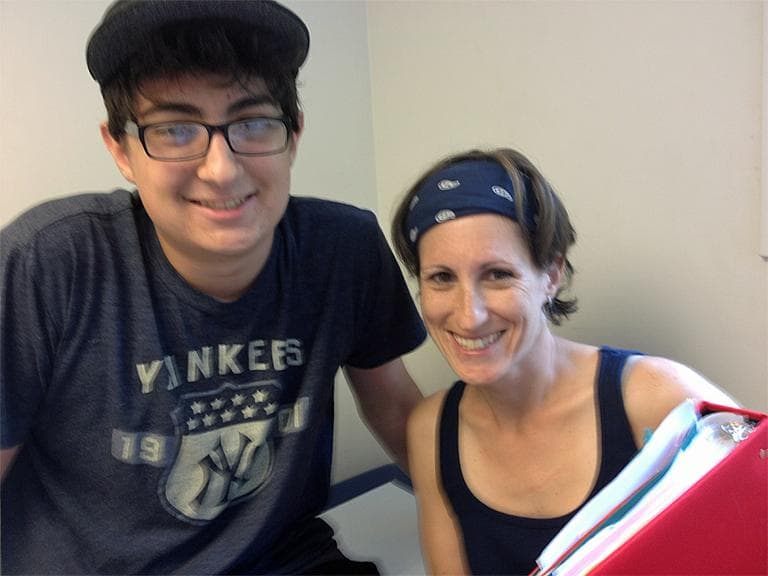Advertisement
The Complexities Of Diagnosing Lyme Disease
ResumeOn Memorial Day weekend, 15-year-old Zachary Tenreiro ran back and forth to the beach through tall grass around his grandmother’s house in Wareham. Three weeks later, Zachary’s legs hang limply off an exam table as his pediatrician, Jennifer Hyde at Westwood-Mansfield Pediatrics, takes notes.
"So can you tell me when the fever started?" Hyde asks, looking up from her keyboard.
"Last night," Zachary mumbles. He’s groggy after a near sleepless night when his fever hit 104.6.
"Did you have any cold symptoms or anything before the fever started?" Hyde asks as she moves quickly through the checklist of symptoms Zachary does not have: no congestion, vomiting or diarrhea. He’s not achy and does not have a stiff neck.

"Do you live in any area where there are deer or ticks?" Hyde says, switching tactics. Zachary’s mother Maria Tenriero jumps in.
"We were down on the Cape where there’s deer and ticks," Maria says, adding that the family always checks for ticks.
"But no tick bites that you noticed?" Hyde wonders.
Maria shakes her head. "I don’t think to check the hair because he’s got so much hair. I don’t even know if I’d see it?"
Zachary hadn't notice a tick or a rash. Hyde tells Zachary he could just have a virus, "but typically, if we have fever and headache, not very strong cold symptoms, we usually do look for the Lyme, especially if you were somewhere where there were ticks."
"And my other son found a tick on his sock," Maria offers.
Hyde sends Zachary for a blood test. If he has Lyme, his blood work should show that he’s producing antibodies. Tests for Lyme don't detect the disease itself. They look for Lyme antibodies, proof that the body is or has been fighting the disease. A few hours before Zachary came in, Hyde had a patient with the telltale bulls-eye rash. She put that boy on antibiotics without ordering a Lyme test.
"There’s no point in testing because the test is unreliable," Hyde explains. "The Lyme antibodies haven’t formed yet, it’s too early."
But Hyde says that for Zachary, the test makes sense.
"With fever this high your body is making lots of anti-Lyme antibodies and it should be there," she says.
That’s if Zachary has Lyme. Hyde offers to start antibiotics right away but Zachary’s mother declines.
"I get very nervous about antibiotics," Maria says. "We don’t use them unless we absolutely have to."
Maria says she’ll fill the prescription if Zachary’s test is positive.
"And if it’s gonna be present, it will, right?" Maria asks. "There’s no way to miss it through blood?"
The answer to that important question is complicated. It depends on when you get the test, says Dr. Philip Molloy, the medical director at Imugen, a Norwood lab that specializes in testing for tick-borne diseases.
"You can’t miss it when it’s late," Molloy says, but "in the first weeks you can be fooled."
Molloy, who is also a rheumatologist, says doctors can be fooled for up to two months after a patient is infected with Lyme because some antibodies show up right away and others take longer to respond to a bacteria, such as Lyme.
"It’s not a reflection of a poor blood test," Molloy says. "It’s a reflection of, you haven’t made antibodies yet. You can’t find what isn’t there. Your body’s immune system takes a week or two to digest this germ and activate its immune system and produce the antibodies that are diagnostic."
Testing for Lyme is a two-step process. The second test, known as the western blot, may be negative even once a patient has a fever or headache if the patient’s antibodies are slow to respond. So Molloy and several infectious disease doctors interviewed for this story recommend retesting patients whose symptoms persist.
The western blot test produces a strip that Molloy says looks kind of like a bar code.
"So there are some weak positives here," Molloy says while looking at western blot strips. "This test, and this test, can only be interpreted in the context of a patient and their EIA results."

The EIA is the first of the two-part test for Lyme. Molloy slips into the medical language that many patients with Lyme learn to speak. His point in looking at these strips with some strong dark bands and some bands that are a faint grey is that knowing when to test for Lyme and how to balance test results against a patient’s symptoms can be tricky for doctors.
"There’s room for being led astray or being confused and there’s so much a paranoia from my patient’s who spend time on the Internet that they sometimes just throw their hat in the air and say, 'I want treatment,' " Molloy says with some frustration in his voice.
Some patients who are sure they have Lyme even though their tests continue to come back negative seek out what they call "Lyme-friendly" labs. These labs don't follow mainstream medical diagnostic standards, but patients say they detect Lyme that mainstream labs miss.
Several patients we spoke to for this series directed us to Nick Harris at IGeneX in California. Harris says it's wrong to suggest that he diagnoses Lyme; that's the role of a doctor. But Harris says he can help patients because "most labs are looking for early Lyme. Our testing goes further and looks at patients infected maybe years before, so it's a criteria difference."
One patient, who says he got very sick before getting a clear diagnosis, is hoping for an entrepreneurial solution.
David Roth, a real estate executive in New York and co-chairman of the Tick-Borne Disease Alliance Board, has put $50,000 of his own money into a partnership with the nonprofit X PRIZE Foundation, to help fund a competition for an early stage Lyme test.
The organization that would decide what test to recommend doctors use, the Infectious Diseases Society of America, says it supports development of new tests and would review the results but stresses that current tests are accurate.
Zachary Tenreiro is still sick. His fever just broke Thursday, seven days after it spiked at 104.6. He developed a full body rash and the headaches continue. Zachary's Lyme test was negative, so Hyde ordered tests for two other serious tick-borne diseases: babesiosis and anaplasmosis as well as mono and a few other possibilities. Hyde and the Tenreiros are waiting for the results.
This program aired on June 29, 2012.
